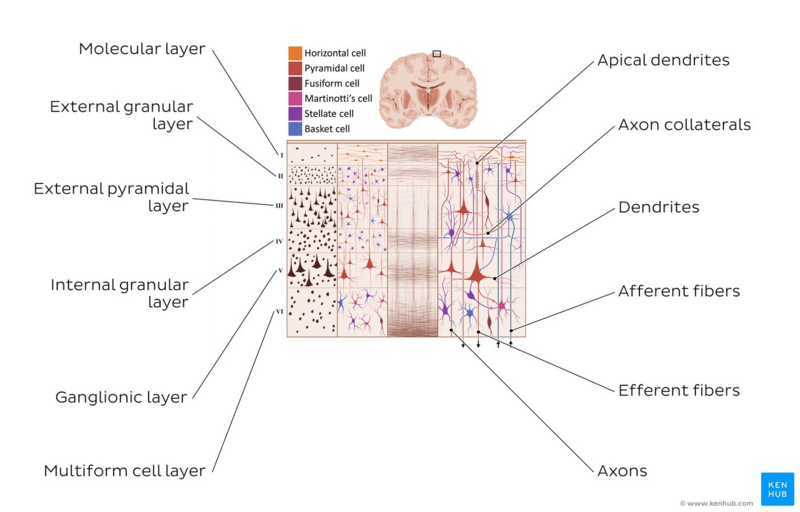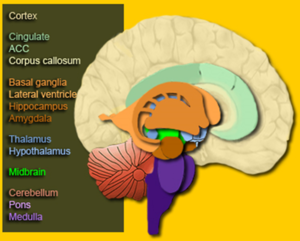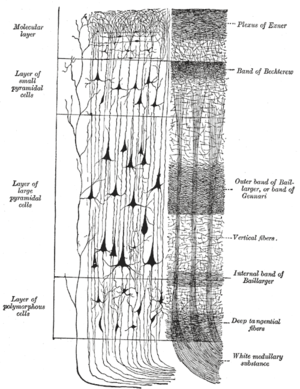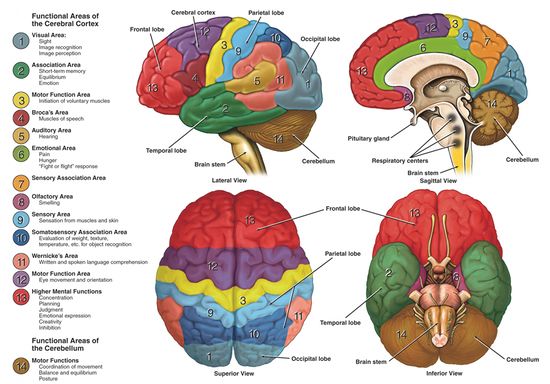which of these would you not find in the cerebral cortex?
Introduction [edit | edit source]
The cerebral cortex is a sheet of neural tissue that is outermost to the cerebrum of the mammalian brain. It has up to six layers of nerve cells. Information technology is covered past the meninges and often referred to as grey matter[ane]. The cortex is gray because nerves in this expanse lack the insulation (myelin) that makes virtually other parts of the brain appear to be white[two].  Image: Layers and cells of the cerebral cortex [iii]
Image: Layers and cells of the cerebral cortex [iii]
The cognitive cortex
- Represents in humans a highly developed structure concerned with the most familiar functions nosotros associate with the human brain. Betwixt fourteen billion and xvi billion neurons are establish in the cerebral cortex.[2]
- Highly convoluted external surface of the encephalon. Its distinctive shape arose during evolution as the volume of the cortex increased more than apace than the cranial book resulting in the convolution of the surface and the folding of the full construction of the cortex. If the cognitive cortex were to be removed and unfolded, it would cover several yards or meters.
- The convolutions consist of grooves known equally sulci that split up the more than elevated regions chosen gyri.
- The cortex has been divided into four lobes using certain consistently nowadays sulci every bit landmarks. These lobes are named after the overlying cranial basic: frontal, parietal, temporal and occipital[4].
The main deviation between cerebrum and cerebral cortex
- The cerebrum is the largest office of the brain whereas cerebral cortex is the outer layer of the cerebrum.
- The cerebral cortex is fabricated upwardly of gray matter (comprises prison cell bodies and dendrites) that covers the internal white matter. Cerebrum is made up of both grey and white matter and comprises both jail cell bodies and nervus fibers.
- The cerebrum is composed of 2 hemispheres. The cerebral cortex is composed of 4 lobes: frontal lobe, parietal lobe, temporal lobe, and occipital lobe.
- The major function of the cerebrum is to control the voluntary muscular movements of the body. The cognitive cortex is mainly involved in the consciousness[v].
Construction [edit | edit source]

The outer layer of the cerebral hemisphere is termed the cerebral cortex. This is inter-connected via pathways that run sub-cortically. It is these connections likewise as the connections from the cognitive cortex to the brainstem, spinal cord and nuclei deep inside the cognitive hemisphere that form the white thing of the cerebral hemisphere. The deep nuclei include structures such as the basal ganglia and the thalamus.
The main difference between cerebrum and cerebral cortex is that cerebrum is the largest part of the encephalon whereas cognitive cortex is the outer layer of the cerebrum. The cerebrum comprises ii cerebral hemispheres. The cerebral cortex is made up of gray affair that covers the internal white matter.[five]
The cerebrum consists of 2 cerebral hemispheres, the correct and left hemisphere are connected by the corpus callosum which facilitates communication between both sides of the brain, with each hemisphere in the main connection to the contralateral side of the body.
The hemispheres are divided into four lobes;
- Occipital
- Parietal
- Temporal (medial function of which are a series of structures including the Hippocampus)
- Frontal
Neocortex [edit | edit source]

The phylogenetically most recent part of the cerebral cortex, the neocortex, has six horizontal layers (the more aboriginal part of the cerebral cortex, the hippocampus, has at most three cellular layers). Neurons in various layers connect vertically to class small-scale microcircuits, chosen 'columns'.
- The neocortex is the newest part of the cognitive cortex to evolve. The six-layer neocortex is a distinguishing feature of mammals; it has been constitute in the brains of all mammals, but non in any other animals. In humans, 90% of the cerebral cortex is neocortex.
- In humans, 90% of the cerebral cortex and 76% of the entire brain is neocortex[vi] [ane]
- The neocortex is the largest and nigh powerful area of the human brain. All of its important cognitive functions are made possible by the convergence of two distinct streams of information: a "lesser-upwardly" stream, which represents signals from the environment, and a "top-down" stream, which transmits internally generated information well-nigh by experiences and current aims.[7]
Image: Cognitive cortex. To the left, the groups of cells; to the right, the systems of fibers. Quite to the left of the effigy a sensory nervus fiber is shown. Prison cell body layers are labeled on the left, and fiber layers are labeled on the right.
Allocortex [edit | edit source]
The allocortex (also known every bit heterogenetic cortex) is a role of the cerebral cortex characterized by fewer prison cell layers than the neocortex (i.e. fewer than six). More aboriginal phylogenetically than the mammals, evolved to handle olfaction and the memory of smells.
The specific regions of the brain normally described as office of the allocortex are:
- Archicortex
-
- Olfactory cortex
- Hippocampus
2. Paleocortex (iii three to five layers)
The cellular organisation of the old cortex is different from the 6-layer structure mentioned above. Unable to grade so many complex micro circuits.
Role [edit | edit source]

The cerebral cortex is involved in several functions of the body including:
- Determining intelligence
- Determining personality
- Motor office
- Planning and organization
- Affect awareness
- Processing sensory information
- Linguistic communication processing
The cerebral cortex contains:
- Sensory areas: receive input from the thalamus and process information related to the senses. They include the visual cortex of the occipital lobe, the auditory cortex of the temporal lobe, the gustatory cortex, and the somatosensory cortex of the parietal lobe. Inside the sensory areas are association areas that requite meaning to sensations and associate sensations with specific stimuli.
2. Motor areas: including the primary motor cortex and the premotor cortex, regulate voluntary movement[2].

Why Wrinkles are Good! [edit | edit source]
Over time, the human being cortex undergoes a procedure of corticalization, or wrinkling of the cortex. This process is due to the vast knowledge that the man brain accumulates over fourth dimension. Therefore, the more wrinkly your brain, the smarter and more intelligent you are![eight]
References [edit | edit source]
- ↑ 1.0 1.1 Kidzsearch Cerebral Cortex Available from:https://wiki.kidzsearch.com/wiki/Cerebral_cortex (accessed 25.12.2020)
- ↑ 2.0 ii.1 2.ii Thought Co. What Does the Brain'south Cerebral Cortex Do? Bachelor from:https://www.thoughtco.com/beefcake-of-the-brain-cognitive-cortex-373217 (accessed 25.12.2020)
- ↑ Layers and cells of the cognitive cortex image - © Kenhub https://www.kenhub.com/en/library/beefcake/cerebral-cortex
- ↑ Nervous organisation Available from:http://world wide web.ifc.unam.mx/Brain/cercox.htm (accessed 25.12.2020)
- ↑ 5.0 five.ane Eppedia Differences between cerebrum and cerebral cortex Available from:https://pediaa.com/difference-betwixt-cerebrum-and-cerebral-cortex/ (accessed 26.12.2020)
- ↑ Science Daily Neocortex Bachelor from:https://www.sciencedaily.com/terms/neocortex.htm (accessed 26.12.2020)
- ↑ medicalxpress Researchers identify a region of the brain equally a central source of signals encoding past experiences in the neocortex Bachelor from: https://medicalxpress.com/news/2020-11-region-brain-key-source-encoding.html (accessed 25.12.20200
- ↑ Brain made simple Cerebral Cortex Available from:https://brainmadesimple.com/cerebral-cortex-and-lobes-of-the-brain/ (accessed 25.12.2020)
Source: https://www.physio-pedia.com/Cerebral_Cortex
Posted by: griffiththerret99.blogspot.com

0 Response to "which of these would you not find in the cerebral cortex?"
Post a Comment